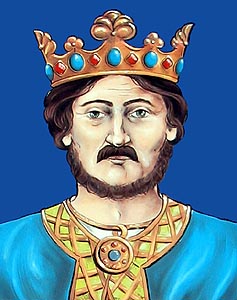 |
 |
|||
|
|
Richard was the second son of King John and his second wife, Isabella of Angouleme. Born in 1209, Richard was fifteen months the junior of his brother, King Henry III. He was educated in England and, in 1227, was given the Earldom of Cornwall. Thenceforth, he was a prominent figure in both English and European politics. Between 1225 and 27, he was Governor of Gascony, but in the following eleven years, he attached himself the Baronial party in opposition to the monarch and his foreign favourites - thus becoming something of a popular hero. In domestic life, Richard married Isabella, daughter of William Marshal, Earl of Pembroke, and widow of Gilbert de Clare, Earl of Hertford & Gloucester, in 1231. They had three sons and one daughter together, but only their son, Henry, survived childhood. When Isabella died after the birth of the last in 1240, Richard decided to escape England and its troubled political atmosphere by taking command of a crusade. Before his departure, he was formally reconciled with his brother, King Henry, and friendly relations were cemented by his marriage with Henry's sister-in-law, Sanchia of Provence, upon his return in 1243. The couple sometimes lived at Berkhamstead Castle or Cippenham Manor in Buckinghamshire, but Wallingford Castle in Berkshire became their chief residence and here Richard spent a fortune on fine building work and lavish entertainments. The eldest of their two children was born at Wallingford. In 1257, the German electors nominated Richard as King of the Romans (ie. Holy Roman Emperor), by a bare majority, and he was persuaded by King Henry to accept the position. Up to 1268, therefore, Richard paid four visits to Germany. However, he only ever obtained recognition in the Rhineland, which had close trade links with England. In the troubles of the same period back in England, Richard attempted to act as a mediator but Civil War broke out, with Simon de Montfort and his followers, in 1264 when Richard took his brother's side. His capture in a windmill after the defeat of the Royalist army at the Battle of Lewes, is commemorated in the earliest of English vernacular satires; and, from then on, he remained a prisoner till the fall of the rebel leader. After the Battle of Evesham, Richard exerted himself, not without some success, to obtain reasonable terms for those who had suffered from the vengeance of the Royalist party. Sanchia had died in 1261 and, eight years later, Richard remarried to Beatrice, daughter of the Count of Falkenburg. However, he himself died on 2nd April 1272, his end being hastened by his grief upon the murder, by the sons of de Montfort, of his eldest son, Henry of Almain. Richard was a great patron of Beaulieu (Hants) and Hayles Abbeys (Glos) where many of his family were buried.
|
|||
| © Nash Ford Publishing 2003. All Rights Reserved. | ||||



 Prince
Richard,
Prince
Richard,